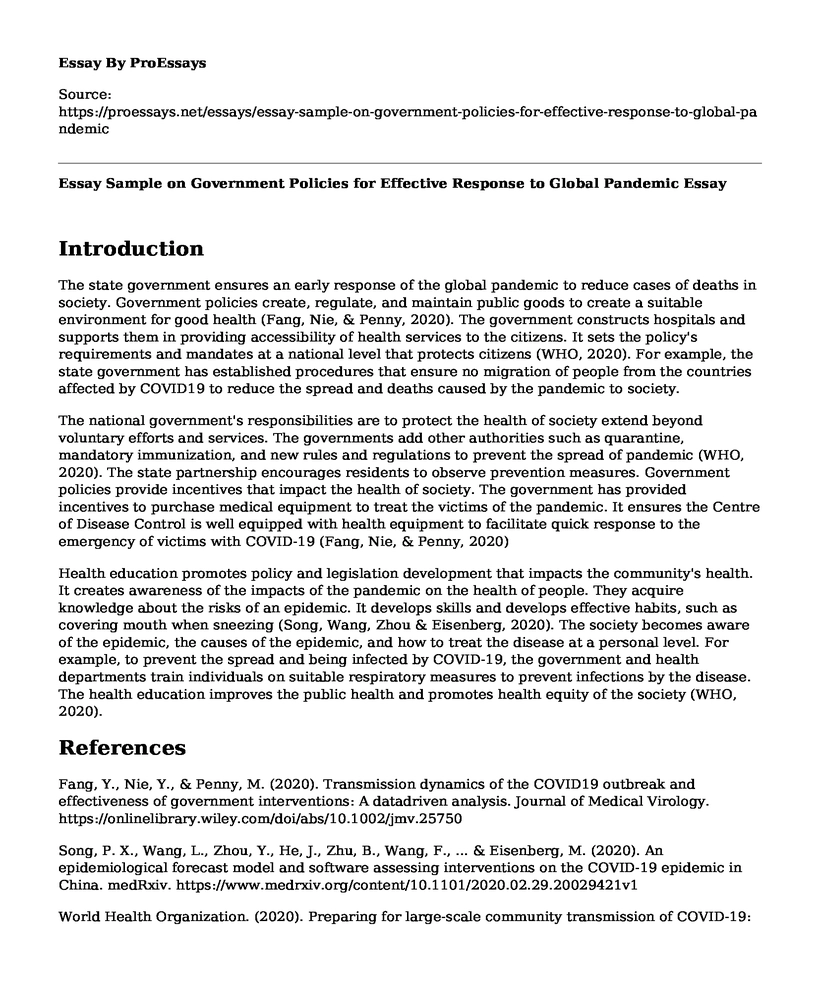Introduction
The state government ensures an early response of the global pandemic to reduce cases of deaths in society. Government policies create, regulate, and maintain public goods to create a suitable environment for good health (Fang, Nie, & Penny, 2020). The government constructs hospitals and supports them in providing accessibility of health services to the citizens. It sets the policy's requirements and mandates at a national level that protects citizens (WHO, 2020). For example, the state government has established procedures that ensure no migration of people from the countries affected by COVID19 to reduce the spread and deaths caused by the pandemic to society.
The national government's responsibilities are to protect the health of society extend beyond voluntary efforts and services. The governments add other authorities such as quarantine, mandatory immunization, and new rules and regulations to prevent the spread of pandemic (WHO, 2020). The state partnership encourages residents to observe prevention measures. Government policies provide incentives that impact the health of society. The government has provided incentives to purchase medical equipment to treat the victims of the pandemic. It ensures the Centre of Disease Control is well equipped with health equipment to facilitate quick response to the emergency of victims with COVID-19 (Fang, Nie, & Penny, 2020)
Health education promotes policy and legislation development that impacts the community's health. It creates awareness of the impacts of the pandemic on the health of people. They acquire knowledge about the risks of an epidemic. It develops skills and develops effective habits, such as covering mouth when sneezing (Song, Wang, Zhou & Eisenberg, 2020). The society becomes aware of the epidemic, the causes of the epidemic, and how to treat the disease at a personal level. For example, to prevent the spread and being infected by COVID-19, the government and health departments train individuals on suitable respiratory measures to prevent infections by the disease. The health education improves the public health and promotes health equity of the society (WHO, 2020).
References
Fang, Y., Nie, Y., & Penny, M. (2020). Transmission dynamics of the COVID19 outbreak and effectiveness of government interventions: A datadriven analysis. Journal of Medical Virology. https://onlinelibrary.wiley.com/doi/abs/10.1002/jmv.25750
Song, P. X., Wang, L., Zhou, Y., He, J., Zhu, B., Wang, F., ... & Eisenberg, M. (2020). An epidemiological forecast model and software assessing interventions on the COVID-19 epidemic in China. medRxiv. https://www.medrxiv.org/content/10.1101/2020.02.29.20029421v1
World Health Organization. (2020). Preparing for large-scale community transmission of COVID-19: guidance for countries and areas in the WHO Western Pacific Region. https://apps.who.int/iris/handle/10665/331243
Cite this page
Essay Sample on Government Policies for Effective Response to Global Pandemic. (2023, Apr 24). Retrieved from https://proessays.net/essays/essay-sample-on-government-policies-for-effective-response-to-global-pandemic
If you are the original author of this essay and no longer wish to have it published on the ProEssays website, please click below to request its removal:
- The Well Being of the Elderly in Asia Versus Europe Essay
- CDC Biosurveillance System Paper Example
- Clinical and Organizational Problem in Memorial Hospital, Jacksonville Paper Example
- The Bhopal Incident Essay Example
- Essay on Social Work: Enhancing Well-Being for the Disadvantaged Community
- Paper Example on the Power of Patient Education: Stabilize, Prevent, & Minimize Illness
- Chinese Scientist 'Playing God': Ethical Debate Over Creation of HIV-Resistant Babies - Free Paper Sample







